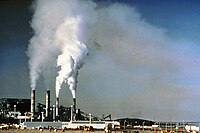
Photo from wikipedia
Acid gas removal is one of the main drivers of operating costs in the flue gas cleaning lines of waste-to-energy (WtE) plants. In the light of updated technical and normative… Click to show full abstract
Acid gas removal is one of the main drivers of operating costs in the flue gas cleaning lines of waste-to-energy (WtE) plants. In the light of updated technical and normative references, such as the revised Best Available Technology reference document for waste incineration in the EU, plants are required to comply with increasingly lower emission limit values (ELV). In the case of existing WtE plants, this requires selecting the appropriate option among three alternatives: intensification of current operations, installation of additional equipment (retrofitting) or substitution of equipment (revamping). The identification of the most cost-effective solution to meet the new ELVs is thus paramount. In the present study, a comparative techno-economic assessment is performed with reference to the relevant options available to WtE plants equipped with a dry acid gas treatment system, explicitly taking into account the influence of several technical and economic variables by a sensitivity analysis. The results show that retrofitting based on furnace sorbent injection is a competitive option especially in the presence of high acid gas loads in the flue gas. Despite the high investment cost, revamping based on conversion to wet scrubbing can also reduce the overall cost of treatment compared to intensification, but only if no constraints are present on flue gas temperature downstream of the acid gas treatment. If flue gas reheating is needed, e.g., for the compatibility with a downstream DeNOx treatment or to avoid plume visibility at stack, the associated costs make revamping not competitive with retrofitting or intensification. Sensitivity analysis confirms that these findings are robust even in presence of relevant variations in cost entries.
Journal Title: Waste management
Year Published: 2023
Link to full text (if available)
Share on Social Media: Sign Up to like & get
recommendations!